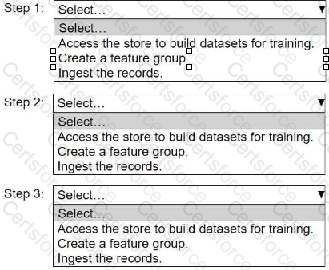An ML engineer needs to create data ingestion pipelines and ML model deployment pipelines on AWS. All the raw data is stored in Amazon S3 buckets.
Which solution will meet these requirements?
An ML engineer needs to use Amazon SageMaker Feature Store to create and manage features to train a model.
Select and order the steps from the following list to create and use the features in Feature Store. Each step should be selected one time. (Select and order three.)
• Access the store to build datasets for training.
• Create a feature group.
• Ingest the records.

A company needs to give its ML engineers appropriate access to training data. The ML engineers must access training data from only their own business group. The ML engineers must not be allowed to access training data from other business groups.
The company uses a single AWS account and stores all the training data in Amazon S3 buckets. All ML model training occurs in Amazon SageMaker.
Which solution will provide the ML engineers with the appropriate access?
A company wants to improve the sustainability of its ML operations.
Which actions will reduce the energy usage and computational resources that are associated with the company's training jobs? (Choose two.)
A company wants to develop an ML model by using tabular data from its customers. The data contains meaningful ordered features with sensitive information that should not be discarded. An ML engineer must ensure that the sensitive data is masked before another team starts to build the model.
Which solution will meet these requirements?
A company is using Amazon SageMaker and millions of files to train an ML model. Each file is several megabytes in size. The files are stored in an Amazon S3 bucket. The company needs to improve training performance.
Which solution will meet these requirements in the LEAST amount of time?
An ML engineer needs to process thousands of existing CSV objects and new CSV objects that are uploaded. The CSV objects are stored in a central Amazon S3 bucket and have the same number of columns. One of the columns is a transaction date. The ML engineer must query the data based on the transaction date.
Which solution will meet these requirements with the LEAST operational overhead?
A company has deployed an ML model that detects fraudulent credit card transactions in real time in a banking application. The model uses Amazon SageMaker Asynchronous Inference. Consumers are reporting delays in receiving the inference results.
An ML engineer needs to implement a solution to improve the inference performance. The solution also must provide a notification when a deviation in model quality occurs.
Which solution will meet these requirements?
Case study
An ML engineer is developing a fraud detection model on AWS. The training dataset includes transaction logs, customer profiles, and tables from an on-premises MySQL database. The transaction logs and customer profiles are stored in Amazon S3.
The dataset has a class imbalance that affects the learning of the model's algorithm. Additionally, many of the features have interdependencies. The algorithm is not capturing all the desired underlying patterns in the data.
Before the ML engineer trains the model, the ML engineer must resolve the issue of the imbalanced data.
Which solution will meet this requirement with the LEAST operational effort?
An ML engineer trained an ML model on Amazon SageMaker to detect automobile accidents from dosed-circuit TV footage. The ML engineer used SageMaker Data Wrangler to create a training dataset of images of accidents and non-accidents.
The model performed well during training and validation. However, the model is underperforming in production because of variations in the quality of the images from various cameras.
Which solution will improve the model's accuracy in the LEAST amount of time?